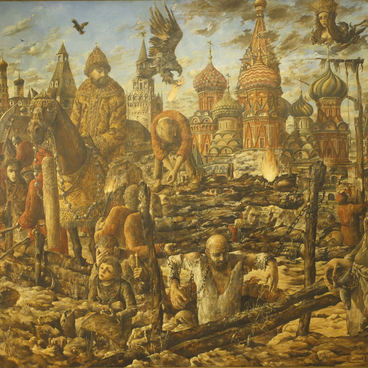A sudarium (literally, handkerchief) is one of veils used to cover sacred vessels during a service. It symbolizes cloths covering Jesus at his birth and the handkerchief used to cover his face in the coffin. Traditionally different veils were used for different vessels. Sudaria with embroidered images of the Theotokos and the Child Jesus, crucifix, half-length depictions of Jesus are used to cover chalices, cups for the consecrated wine and Holy Communion. Patens, liturgical plates, are covered with veils with several variants of the plot The Lamb of God.
The Lamb of God is a symbolic title for Jesus that highlights his self-sacrifice. Events during the times of the Old Testament were its prototype, it is considered that the first sacrifice were made by Adam and Eve, the life of their sons Cain and Abel were also connected with sacrifices.
The sudarium from the collection of the museum was made before Peter the Great times. It was created in Epiphany Convent of Uglich in the 17th century. On the sudarium Jesus is depicted on the paten surrounded by angels while cherubim, winged celestial beings, are flying above. On the upper part of the sudarium there is an inscription ‘Се агнец божий вземяй грехи мира’ (Behold the Lamb of God who takes away the sin of the world.).
The sudarium is made from satin, closely woven silk with a smooth face. The face and figure of Jesus are embroidered in satin stitch with silk threads of nude color. Aureole, paten and eight-ray asterisks are made with decorative gold and silver threads. They are worked in couching stitches in which they are fastened in place with small stitches of thrown silk. Garments, wings and aureoles of the angels are also made with gold and silver threads. The embroiderer was very good at depicting faces and other small details, she carefully made all stitches and matched colors while proving her great skill.
This plot was seldom painted on icons, however, it was widely used for veils for patens, for example, sudarium of the 17th century with similar depiction is kept in the Russian Museum. The central image on the folding Old Believers icon The Lamb of God of the 17th-18th centuries can be regarded as an example of such depiction among icons.
The Lamb of God is a symbolic title for Jesus that highlights his self-sacrifice. Events during the times of the Old Testament were its prototype, it is considered that the first sacrifice were made by Adam and Eve, the life of their sons Cain and Abel were also connected with sacrifices.
The sudarium from the collection of the museum was made before Peter the Great times. It was created in Epiphany Convent of Uglich in the 17th century. On the sudarium Jesus is depicted on the paten surrounded by angels while cherubim, winged celestial beings, are flying above. On the upper part of the sudarium there is an inscription ‘Се агнец божий вземяй грехи мира’ (Behold the Lamb of God who takes away the sin of the world.).
The sudarium is made from satin, closely woven silk with a smooth face. The face and figure of Jesus are embroidered in satin stitch with silk threads of nude color. Aureole, paten and eight-ray asterisks are made with decorative gold and silver threads. They are worked in couching stitches in which they are fastened in place with small stitches of thrown silk. Garments, wings and aureoles of the angels are also made with gold and silver threads. The embroiderer was very good at depicting faces and other small details, she carefully made all stitches and matched colors while proving her great skill.
This plot was seldom painted on icons, however, it was widely used for veils for patens, for example, sudarium of the 17th century with similar depiction is kept in the Russian Museum. The central image on the folding Old Believers icon The Lamb of God of the 17th-18th centuries can be regarded as an example of such depiction among icons.
Some Christians believe that the sudarium of Jesus Christ described in the Gospels has been preserved to our days. A piece of linen cloth with traces of blood and lymph is stored in the Cathedral of San Salvador, Oviedo, Spain, and regarded as relics. Scientists discovered that this cloth had covered the face of a person who was in the vertical position with his hands up and his right cheek touched his shoulder. The history of the relics dated back to the 7th century and it was presumed to have been taken from Palestine.Some Christians believe that the sudarium of Jesus Christ described in the Gospels has been preserved to our days. A piece of linen cloth with traces of blood and lymph is stored in the Cathedral of San Salvador, Oviedo, Spain, and regarded as relics. Scientists discovered that this cloth had covered the face of a person who was in the vertical position with his hands up and his right cheek touched his shoulder. The history of the relics dated back to the 7th century and it was presumed to have been taken from Palestine.



